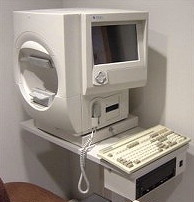 World Sight Day
World Sight Day is an international “day of awareness,” coordinated by the
International Agency for the Prevention of Blindness (IAPB).
The purpose of World Site Day is to focus attention on the global issue of avoidable blindness and visual impairment. It is held each year on the second Thursday of October.
This year, World Sight Day will be held on
October 11, 2018, with the theme of Eye Care Everywhere.
Important Messages on World Sight Day
These are the key international messages for World Sight Day:
- Approximately 285 million people worldwide live with low vision and blindness.
- Of these, 39 million people are blind and 246 million have moderate or severe visual impairment.
- 1.2 billion people don’t have access to glasses.
- 90% of blind people live in low-income countries.
- 80% of visual impairment is avoidable, meaning readily treatable and/or preventable.
- Restorations of sight and blindness prevention strategies are among the most cost-effective interventions in health care.
- About 65% of all people who are visually impaired are aged 50 and older, while this age group comprises only 20% of the world’s population.
- Increasing elderly populations in many countries mean that more people will be at risk of age-related visual impairment.
More About “Avoidable Blindness”
The International Agency for the Prevention of Blindness (IAPB) describes avoidable blindness and eye diseases that cause blindness as follows:
- Aging and the Eye: “Vision loss does not need to be an inevitable part of the aging process. Thanks to improvements in diagnosis, treatment, and prevention, people can age with healthy vision.” You can read more about these age-related eye diseases and disorders at For Seniors: Age-Related Vision Loss at VisionAware.
- Cataract: “the condition responsible for 48% of world blindness.” You can read more about cataracts and cataract surgery at Cataracts at VisionAware.
- Diabetic Retinopathy: “Diabetes is becoming a global epidemic and is now one of the top causes of vision loss globally.” You can read more about diabetes and diabetic retinopathy at Introduction to Diabetes and Diabetic Retinopathy at VisionAware.
- Glaucoma: “the second leading cause of blindness and the leading cause of irreversible blindness worldwide.” You can read more about glaucoma and glaucoma treatments at Glaucoma at VisionAware.
- Age-Related Macular Degeneration (AMD): “the third most important cause of blindness in the world and the leading cause of blindness in higher-income countries with aging populations.” You can read more about macular degeneration causes, treatments, and research at Age-Related Macular Degeneration at VisionAware.
- Health Systems: “Historically, eye care has been seen as separate from the rest of health system but there is now widespread recognition that those planning and delivering eye care need to engage with the wider health system in order to develop effective and sustainable eye care interventions.” You can read more about the different types of eye care professionals at VisionAware.
- Human Resources for Eye Health: “one of the building blocks of a health system. A well-equipped, trained, managed, and distributed health workforce is essential for a fully functional health system, responsive to the needs of the community it serves.” You can read more about human resources and eye health at VisionAware.
- Low Vision: “Of the 285 million people worldwide with vision impairment, there are 80 million people who have permanent vision impairment and potentially can benefit from low vision services. Most of those with low vision are older people and the numbers will double over the next 20-30 years.” You can read more about low vision examinations and services at What Is Low Vision? at VisionAware.
On World Sight Day, Schedule a Comprehensive Eye Examination
A comprehensive dilated eye examination generally lasts between 30 and 60 minutes, and is performed by an
ophthalmologist or
optometrist. It should always include the following components:
A Health and Medication History
- Your overall health and that of your immediate family
- The medications you are taking (both prescription and over-the-counter)
- Questions about high blood pressure (hypertension), diabetes, smoking, and sun exposure.
A Vision History
- How well you can see at present, including any recent changes in your vision
- Eye diseases that you or your family members have had, including macular degeneration and glaucoma
- Previous eye treatments, surgeries, or injuries
- The date of your last eye examination
As part of the vision history, the doctor may ask you the following questions:
- Are you having any problems with your vision?
- How long have you had these problems?
- When do these problems occur?
- When was your last eye examination?
- Do you have any family history of eye problems?
- How is your general health?
- What medications are you taking?
- Do you have any allergies?
This history of your own health and that of your family can give the doctor an indication of any issues that may be affecting, or could affect, your vision.
An Eye Health Evaluation
- An examination of the external parts of your eyes: the whites of the eyes, the iris, pupil, eyelids, and eyelashes.
- A dilated eye (or fundus) examination that can be achieved with the use of special lenses will allow your doctor to see inside your eye and examine the retina and optic nerve. Your doctor might choose to use eye drops to see the retina and optic nerve more clearly.
- A test of the fluid pressure within your eyes to check for the possibility of glaucoma.
A Refraction, or Visual Acuity Testing
A refraction helps determine the sharpness or clarity of both your near (reading) and distance vision.
This includes testing your vision with lenses in different strengths to determine if your vision can be improved or corrected with regular glasses or contact lenses.
Visual Field Testing
Visual field testing helps determine how much side (or peripheral) vision you have and how much surrounding area you can see.

The most common type of visual field test in a comprehensive eye exam is called a
confrontation field test, in which the doctor briefly flashes several fingers in each of the four quadrants (above, below, right, and left) of your visual field while seated opposite you.
In some cases, your doctor may also want to perform a more precise visual field measurement, using a computerized visual field analyzer, such as the Humphrey Field Analyzer (pictured at left).
Your Examination Results
The doctor will be able to determine if the visual problems you are experiencing are normal age-related changes or are disease-related, and if additional testing, referral to another doctor or specialist, or treatments are needed.
Locate an Eye Care Professional in Your Area
 World Sight Day is an international “day of awareness,” coordinated by the International Agency for the Prevention of Blindness (IAPB).
The purpose of World Site Day is to focus attention on the global issue of avoidable blindness and visual impairment. It is held each year on the second Thursday of October.
This year, World Sight Day will be held on October 11, 2018, with the theme of Eye Care Everywhere.
World Sight Day is an international “day of awareness,” coordinated by the International Agency for the Prevention of Blindness (IAPB).
The purpose of World Site Day is to focus attention on the global issue of avoidable blindness and visual impairment. It is held each year on the second Thursday of October.
This year, World Sight Day will be held on October 11, 2018, with the theme of Eye Care Everywhere.
 The most common type of visual field test in a comprehensive eye exam is called a confrontation field test, in which the doctor briefly flashes several fingers in each of the four quadrants (above, below, right, and left) of your visual field while seated opposite you.
In some cases, your doctor may also want to perform a more precise visual field measurement, using a computerized visual field analyzer, such as the Humphrey Field Analyzer (pictured at left).
The most common type of visual field test in a comprehensive eye exam is called a confrontation field test, in which the doctor briefly flashes several fingers in each of the four quadrants (above, below, right, and left) of your visual field while seated opposite you.
In some cases, your doctor may also want to perform a more precise visual field measurement, using a computerized visual field analyzer, such as the Humphrey Field Analyzer (pictured at left).